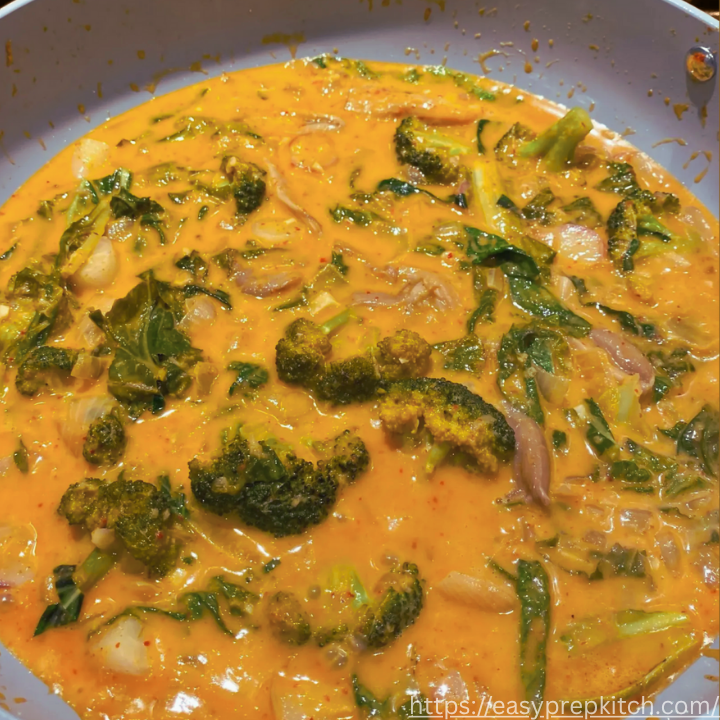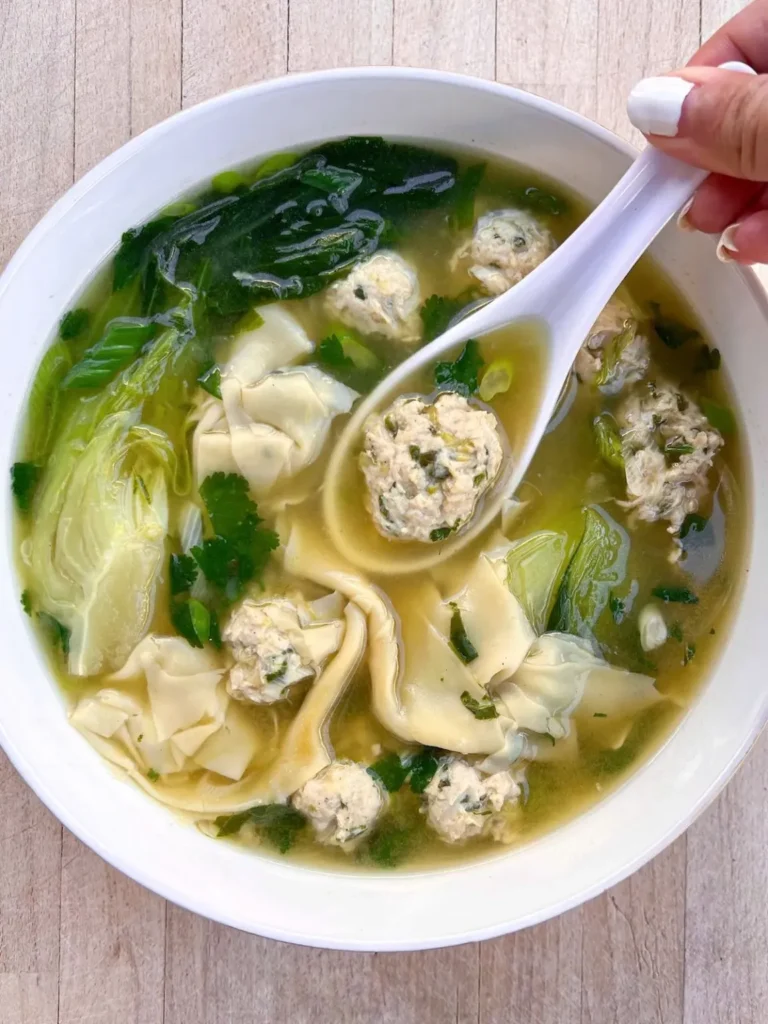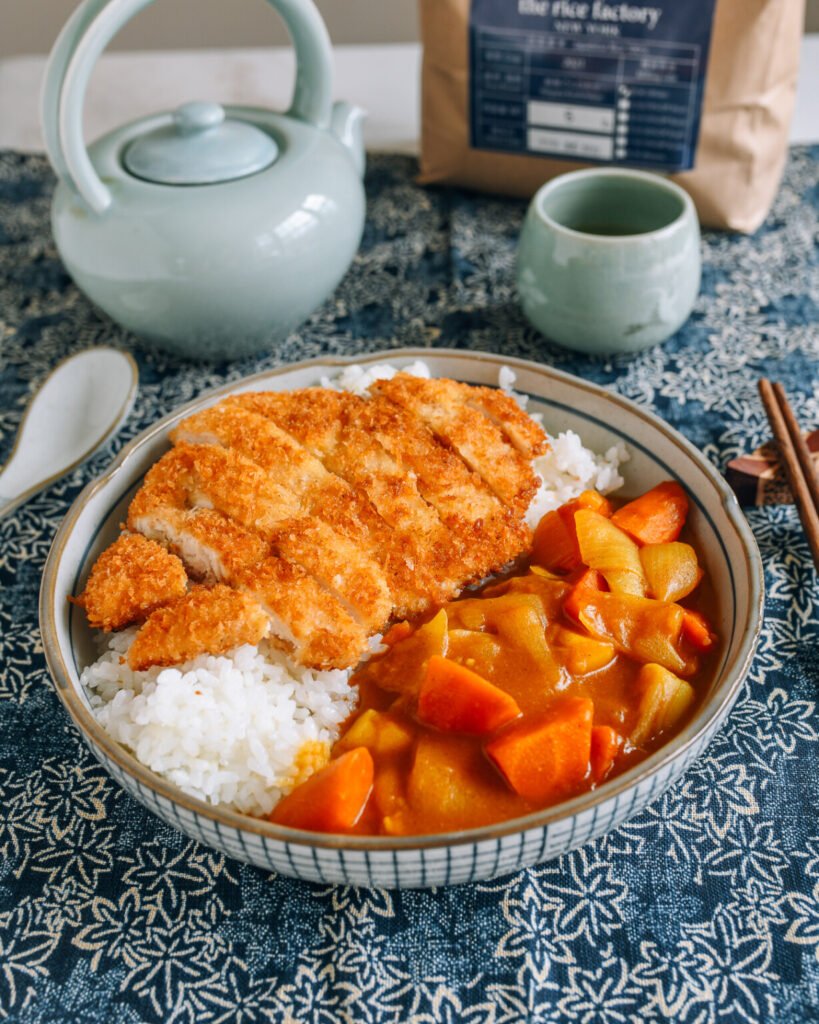Thai red coconut curry is one of those dishes I return to again and again, not just because it’s easy, but because it feels good to eat. It’s one of the first things I learned to make when I started cooking more plant-based meals at home. The rich aromatic spices, creamy texture, and warmth of the dish give it that “cozy in a bowl” feeling. On days when I’m tired or just need something comforting without too much effort, this curry is my go-to. It’s fast, filling, and feels like I’m doing something kind for my body.
One of the best parts? It’s fully vegetarian, vegan, and gluten-free—and still so full of flavor. You don’t need fancy ingredients. Just some basic pantry staples, a can of coconut milk, and a mix of fresh or frozen vegetables. The way the creamy coconut base wraps around the veggies brings out their natural sweetness and balances the spicy red curry paste. What surprised me most the first time I made it? How nourishing and satisfying it was without any meat. It’s packed with plant-based protein, fiber, and just the right amount of heat. Since then, I’ve made it on repeat—especially when I need something healthy, warming, and homemade without the fuss of takeout.
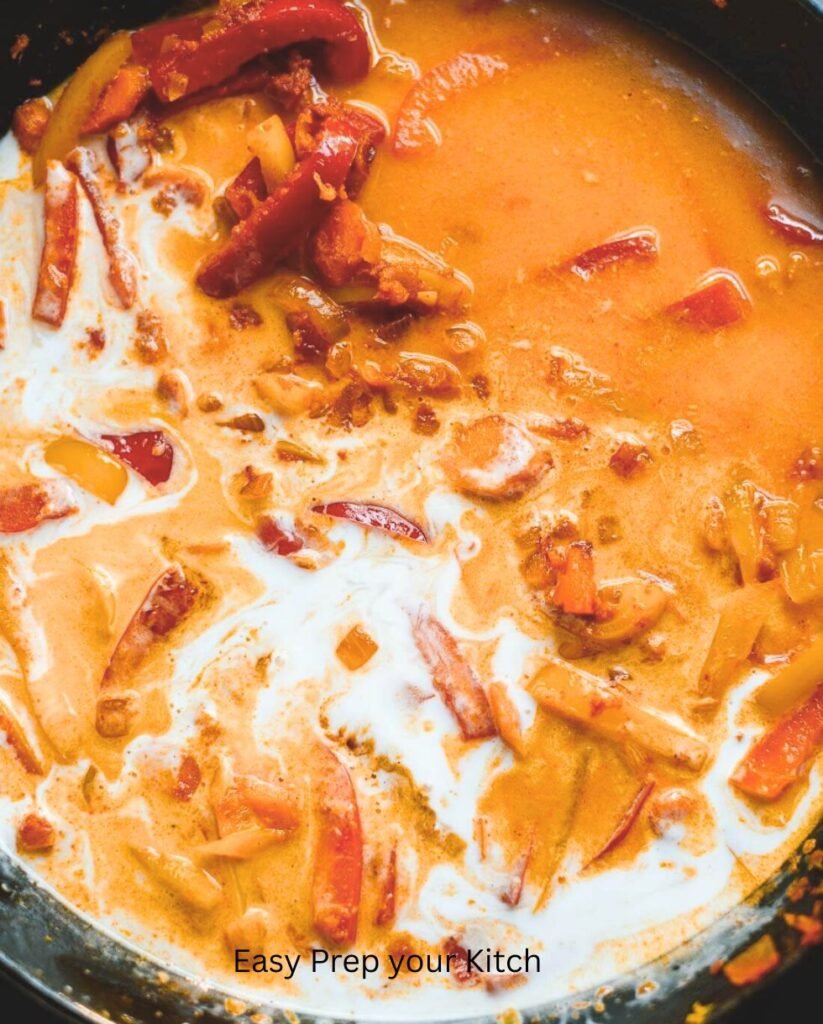
What is Thai Curry?
Thai curry is such a fun and flexible dish to cook. I remember the first time I tried making it at home—I didn’t expect it to be so easy or so packed with flavor. In Thailand, there are different versions like yellow, green, and red curry, and each has its own taste and vibe. Red curry paste is one of the most popular, and for good reason. It usually includes red peppers, lemongrass, garlic, and other bold spices that give it that rich, savory heat. One thing I love about red curry is how easy it is to use—it’s great for quick dinners like noodles or a warm, comforting curry. While I’ve also made panang and massaman curries, red curry is my go-to. It’s flavorful, versatile, and always hits the spot when I want something simple but satisfying.
Why you’ll love this easy Thai red curry recipe
- Quick and easy to make in just 30 minutes:
This dish is great when you’re short on time but still want a warm and flavorful meal with authentic Thai red curry taste. I cook every day, and I always go back to this recipe when I want something quick that feels fresh. You’ll get a full dinner on the table in under 30 minutes, with rich spices and creamy coconut milk that taste like they took hours to make. - Flexible recipe: swap ingredients to suit your tastes.
You can make it spicy or mild. Just change how much Thai red curry paste you use. I like to add a squeeze of lime juice or some fresh Thai basil for balance. Use any veggies you like—zucchini, carrots, even frozen mixes. This dish fits whatever’s in your kitchen and still turns out delicious. - Packed with protein and fresh vegetables for a nutritious meal:
Each bowl gives you flavor and nutrition. Add tofu, chickpeas, or tempeh to get more plant-based protein. I often throw in extra broccoli or snap peas from my garden. These add color, fiber, and help you feel full longer. That’s important on busy nights when I need lasting energy. - One large skillet for easy cleanup:
No one likes a big mess after dinner. That’s why I love using just one skillet. You cook everything—sauté, simmer, and serve—in the same pan. I prep meals every week, so this easy clean-up really helps save time and effort. Less mess means more time to relax. - Bursting with bold, vibrant, and Thai-inspired flavors:
You get the deep taste of Thailand right at home. The mix of red curry paste, ginger, and garlic fills your kitchen with mouthwatering smells. I still remember the first time I made it—my family ran in from the other room because it smelled so good. It’s rich, spicy, and has that classic Thai umami flavor everyone loves.
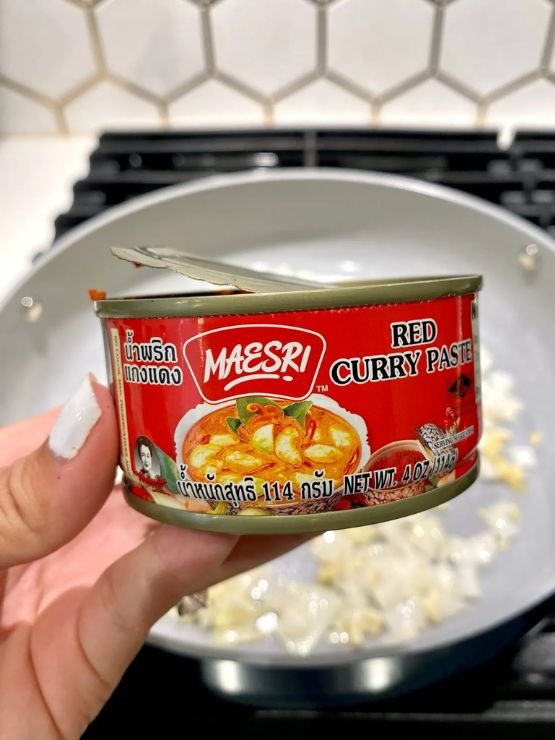
Curry Paste
The secret to a rich and flavorful Thai Red Coconut Veggie Curry lies in the curry paste. While you can make it from scratch, I’ve found that using pre-made paste saves a lot of time without compromising on taste.
A good brand like Maesri, adds the perfect balance of spicy and aromatic flavors. I love that it comes in a tin can, and you can easily find it at Asian grocery stores like H Mart or 99 Ranch, or even buy it on Amazon.
Not only does Maesri offer a spicy version, but they also have different flavors that you can use for other types of Thai curries, making it a versatile ingredient for your kitchen.
This simple yet essential step ensures that your curry is full of authentic flavorful goodness.
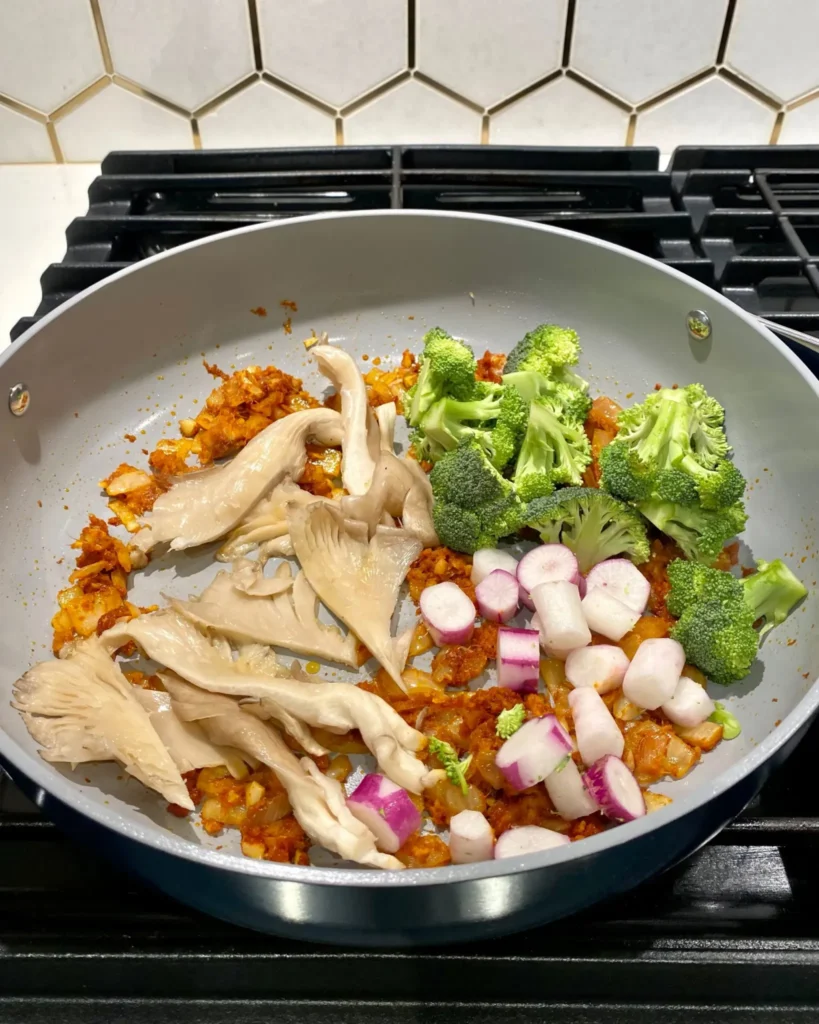
Veggie or Protein Options for Curry
When it comes to building a customizable Thai red curry, I always tell friends it’s one of the most flexible dishes in my weekly rotation. You can make it vegetarian or protein-rich, depending on what you need that day.
I often use up extra carrots, sweet potatoes, red bell peppers, mushrooms, spinach, or onions—these veggies not only brighten up the dish but also add a variety of vitamins and fiber that leave you full and satisfied. If I’m clearing out the fridge, this combo is a no-brainer.
When simmered in a creamy coconut curry sauce, these vegetables soak up that deep, aromatic flavor and make the dish taste like it’s been cooking for hours.
Now, if you want to add some protein, you’ve got great choices: chicken, eggs, meat, shrimp, or beef all work really well. I’ve done all of them depending on the season or who I’m cooking for. Just make sure to sear the meat first so it locks in flavor before you simmer it with the curry.
Whether you go for a plant-based version or a protein-packed one, the dish still delivers big flavor and nutrition. I’ve made this on busy weeknights, rainy weekends, and even when guests drop in unexpectedly.
No matter what, it turns out comforting and satisfying every time—and I always get asked for the recipe. It’s the kind of meal that lets you be creative and still feel like you’ve made something special.
Variations
This dish is super versatile, which means you can easily make it your own—even on the busiest nights. I often turn to this curry when I’ve got leftover veggies or want something filling without much effort.
- Mix and match vegetables like zucchini, green beans, peas, or sweet potatoes. These all cook well in the curry base and soak up the bold flavors. I once used just green beans and carrots, and it still tasted amazing.
- Don’t have fresh produce? Use frozen vegetables for convenience—just toss in a bag of pre-chopped veggies straight from the freezer. No chopping, no fuss.
- Need more staying power? Add plant protein like baked tofu, fried tempeh, soy curls, or chickpeas. I usually add chickpeas because they’re quick, affordable, and always in my pantry.
- Want it less spicy? Just adjust the spice level with a mild red curry paste. You can also reduce the amount to 2 tablespoons if you’re cooking for kids or prefer a gentler heat.
- It’s quick to prepare and comes together fast, giving you a satisfying meal that tastes like takeout but is way healthier and homemade.
Thai Red Curry Expert Tips
- Use aromatics like onion, garlic, and ginger to build the flavor.
- Opt for full-fat coconut milk to add richness and creaminess.
- Add rice vinegar and sugar for extra complexity.
- Choose store-bought Thai red curry paste like Thai Kitchen for convenience.
- Chop vegetables into small, even pieces for even cooking, and adjust cooking time for harder vegetables like sweet potato or butternut squash.
How to store
It’s super simple to store Thai red curry. I usually let it cool down a bit first, then place it in an airtight container and pop it in the fridge for 3–5 days. This method helps preserve the flavor and texture, especially with ingredients like coconut milk and fresh vegetables. While I haven’t personally tried freezing it yet, I’ve heard from other home cooks that it works well depending on the veggies used—bell peppers and snap peas might soften a bit.
If you do freeze it, I’d suggest reheating it gently and adding a little more red curry paste or coconut milk to freshen up the flavor. That trick helps bring back the richness I love. I’ve even used a splash of vegetable broth once when it felt too thick after reheating—it worked like magic. This is one of those recipes that’s even better the next day, making it perfect for meal prep lovers or busy weeknight dinners.
More Recipes You Might Like
Vegan Thai Red Curry with Coconut Milk –So Easy, So Good!
Description
Thai Red Curry is a bold, flavorful dish made with a fragrant blend of red curry paste, creamy coconut milk, and a colorful medley of vegetables, tofu, or protein of your choice. Known in Thailand as "Gaeng Phed", this classic Thai curry is beloved for its balance of spicy, sweet, and savory notes, making it a go-to comfort food across the globe.
What makes this dish stand out is its rich base of lemongrass, garlic, galangal, and kaffir lime leaves, infused into the red curry paste—a staple in authentic Thai cooking. Simmered in full-fat coconut milk, the result is a luxuriously creamy sauce that clings to every ingredient. You’ll often find bell peppers, bamboo shoots, Thai basil, and carrots in the mix, but the recipe is incredibly flexible and perfect for using seasonal produce.
Ingredients
Nutrition Facts
Servings 4
- Amount Per Serving
- Calories 1113kcal
- % Daily Value *
- Total Fat 99.26g153%
- Saturated Fat 85.88g430%
* Percent Daily Values are based on a 2,000 calorie diet. Your daily value may be higher or lower depending on your calorie needs.
Note
- For a lighter version of this Thai Red Coconut Veggie Curry, you can replace some of the coconut milk with vegetable stock.
- Feel free to use homemade coconut milk or canned, depending on what you have. If you're looking to save cooking time, consider using quick-cook veggies or even frozen options. Rice or microwave grains are a great addition, and will make your meal ready in no time.
- If you're looking to add some protein, chickpeas, tofu, or any of your favorite protein sources work well. For vegetables, you can use options like zucchini, sweet potato, eggplant, baby corn, green beans, butternut squash, or cauliflower.
- To customize the spice level, you can adjust the heat by adding chili, red pepper flakes, or a dash of chili oil to the plates for those who like an extra kick. This recipe is highly flexible, so feel free to mix and match veggies to suit your tastes!
